Joint Probabilistic Modeling of Wind Speed and Wind Direction for Wind Energy Analysis: A Case Study in Humansdorp and Noupoort
Abstract
1. Introduction
2. Site Location and Wind Data
3. Models
4. Materials and Methods
4.1. Fitting of the System of Wind Distributions
4.2. Evaluation of Goodness-of-Fit
| Algorithm 1 Maximum likelihood (ML) estimation algorithm for semi-parametric Möbius model on the disc (SPM) model. |
|
4.3. Influence of Wind Speed and Wind Direction Data
5. Results and Discussion
- For the Humansdorp location at 20 m, the SPM model performs the best overall. The BM model performs the best from the parametric models.
- For the Humansdorp location at 60 m, the SPM model performs the best overall. The MD model performs the best from the parametric models.
- For the Noupoort location at 20 m, the SPM model performs the best overall. The BM model performs the best from the parametric models.
- For the Noupoort location at 60 m, the SPM model performs the best overall. The BM model performs the best from the parametric models.
- The SPM model outperforms overall based on the performance measures. This model has the advantage of limited distributional assumptions. However, it is worth noting that the selection of the bandwidth plays an important role in statistical analysis.
6. Conclusions
Author Contributions
Funding
Acknowledgments
Conflicts of Interest
Abbreviations
| a | Skewness parameter of distribution on a disc |
| AIC | Akaike information criterion |
| BIC | Bayesian information criterion |
| Beta type III Möbius distribution on a disc | |
| CDF | Cumulative distribution function |
| Joint probability density function (PDF) of wind speed and wind direction | |
| General Möbius distribution on a disc | |
| HQC | Hannan–Quinn information criterion |
| k | Circular kurtosis |
| KDE | Kernel density estimation |
| Maximum value of the likelihood function | |
| Log likelihood function | |
| Möbius distribution on a disc | |
| ML | Maximum likelihood |
| n | Total number of data points |
| p | Number of estimated parameters |
| Probability density function | |
| Wind power density (W/m) | |
| Correlation coefficient of linear and angular variables | |
| s | Circular skewness |
| Semi-parametric Möbius model on the disc | |
| Circular variance | |
| Mean resultant length | |
| x | Wind speed |
| Greek Letters | |
| Concentration parameter of distributions on disc | |
| Circular dispersion | |
| Concentration parameter of distributions on disc | |
| Orientation parameter of distributions on a disc | |
| Circular standard deviation | |
| Air density (kg/m) | |
| Wind direction | |
| Mean direction | |
| Mean direction | |
References
- Saidur, R.; Rahim, N.; Islam, M.; Solangi, K. Environmental impact of wind energy. Renew. Sustain. Energy Rev. 2011, 15, 2423–2430. [Google Scholar] [CrossRef]
- Jung, C.; Schindler, D. Sensitivity analysis of the system of wind speed distributions. Energy Convers. Manag. 2018, 177, 376–384. [Google Scholar] [CrossRef]
- Carta, J.; Ramirez, P.; Velazquez, S. A review of wind speed probability distributions used in wind energy analysis: Case studies in the Canary Islands. Renew. Sustain. Energy Rev. 2009, 13, 933–955. [Google Scholar] [CrossRef]
- Soukissian, T.H.; Karathanasi, F.E. On the selection of bivariate parametric models for wind data. Appl. Energy 2017, 188, 280–304. [Google Scholar] [CrossRef]
- Porté-Agel, F.; Wu, Y.T.; Chen, C.H. A numerical study of the effects of wind direction on turbine wakes and power losses in a large wind farm. Energies 2013, 6, 5297–5313. [Google Scholar] [CrossRef]
- Herbert-Acero, J.; Probst, O.; Réthoré, P.E.; Larsen, G.; Castillo-Villar, K. A review of methodological approaches for the design and optimization of wind farms. Energies 2014, 7, 6930–7016. [Google Scholar] [CrossRef]
- Waewsak, J.; Chaichana, T.; Chancham, C.; Landry, M.; Gagnonc, Y. Micro-siting wind resource assessment and near Shore wind farm analysis in Pakpanang district, Nakhon Si Thammarat province, Thailand. Energy Procedia 2014, 52, 204–215. [Google Scholar] [CrossRef][Green Version]
- Zhang, M.H. Wind Resource Assessment and Micro-Siting: Science and Engineering; John Wiley & Sons: Hoboken, NJ, USA, 2015. [Google Scholar]
- Song, M.; Chen, K.; Zhang, X.; Wang, J. Optimization of wind turbine micro-siting for reducing the sensitivity of power generation to wind direction. Renew. Energy 2016, 85, 57–65. [Google Scholar] [CrossRef]
- Carta, J.A.; Ramirez, P.; Bueno, C. A joint probability density function of wind speed and direction for wind energy analysis. Energy Convers. Manag. 2008, 49, 1309–1320. [Google Scholar] [CrossRef]
- Han, Q.; Hao, Z.; Hu, T.; Chu, F. Non-parametric models for joint probabilistic distributions of wind speed and direction data. Renew. Energy 2018, 126, 1032–1042. [Google Scholar] [CrossRef]
- Feng, J.; Shen, W. Modelling wind for wind farm layout optimization using joint distribution of wind speed and wind direction. Energies 2015, 8, 3075–3092. [Google Scholar] [CrossRef]
- Sanusi, N.; Zaharim, A.; Mat, S.; Sopian, K. Comparison of Univariate and Bivariate Parametric Model for Wind Energy Analysis. J. Adv. Res. Fluid Mech. Therm. Sci. 2018, 49, 1–10. [Google Scholar]
- Gugliani, G.; Sarkar, A.; Ley, C.; Mandal, S. New methods to assess wind resources in terms of wind speed, load, power and direction. Renew. Energy 2018, 129, 168–182. [Google Scholar] [CrossRef]
- Zhang, J.; Chowdhury, S.; Messac, A.; Castillo, L. A multivariate and multimodal wind distribution model. Renew. Energy 2013, 51, 436–447. [Google Scholar] [CrossRef]
- Ley, C.; Verdebout, T. Modern Directional Statistics; CRC Press: Boca Raton, FL, USA, 2017. [Google Scholar]
- Johnson, R.A.; Wehrly, T. Measures and models for angular correlation and angular–linear correlation. J. R. Stat. Soc. Ser. B (Methodol.) 1977, 39, 222–229. [Google Scholar] [CrossRef]
- Zhang, L.; Li, Q.; Guo, Y.; Yang, Z.; Zhang, L. An investigation of wind direction and speed in a featured wind farm using joint probability distribution methods. Sustainability 2018, 10, 4338. [Google Scholar] [CrossRef]
- Basile, S.; Burlon, R.; Morales, F. Joint probability distributions for wind speed and direction. A case study in Sicily. In Proceedings of the 2015 International Conference on Renewable Energy Research and Applications (ICRERA), Palermo, Italy, 22–25 November 2015; pp. 1591–1596. [Google Scholar]
- Erdem, E.; Shi, J. Comparison of bivariate distribution construction approaches for analysing wind speed and direction data. Wind Energy 2011, 14, 27–41. [Google Scholar] [CrossRef]
- Hennessey, J.P., Jr. A comparison of the Weibull and Rayleigh distributions for estimating wind power potential. Wind Eng. 1978, 2, 156–164. [Google Scholar]
- Mardia, K.V.; Jupp, P.E. Directional Statistics; John Wiley & Sons: Hoboken, NJ, USA, 2009; Volume 494. [Google Scholar]
- Bekker, A.; Nagar, P.; Arashi, M.; Rautenbach, H. From Symmetry to Asymmetry on the Disc Manifold: Modeling of Marion Island Data. Symmetry 2019, 11, 1030. [Google Scholar] [CrossRef]
- Burnham, K.P.; Anderson, D.R. A practical information-theoretic approach. Model Selection and Multimodel Inference, 2nd ed.; Springer: New York, NY, USA, 2002. [Google Scholar]
- Fabozzi, F.J.; Focardi, S.M.; Rachev, S.T.; Arshanapalli, B.G. The Basics of Financial Econometrics: Tools, Concepts, and Asset Management Applications; John Wiley & Sons: Hoboken, NJ, USA, 2014. [Google Scholar]
- Wagenmakers, E.J.; Ratcliff, R.; Gomez, P.; Iverson, G.J. Assessing model mimicry using the parametric bootstrap. J. Math. Psychol. 2004, 48, 28–50. [Google Scholar] [CrossRef]
- Claeskens, G.; Carroll, R.J. An asymptotic theory for model selection inference in general semiparametric problems. Biometrika 2007, 94, 249–265. [Google Scholar] [CrossRef]
- Murphy, S.A.; Van der Vaart, A.W. On profile likelihood. J. Am. Stat. Assoc. 2000, 95, 449–465. [Google Scholar] [CrossRef]
- Xu, R.; Vaida, F.; Harrington, D.P. Using profile likelihood for semiparametric model selection with application to proportional hazards mixed models. Stat. Sin. 2009, 19, 819. [Google Scholar] [PubMed]
- Fu, Y.Z.; Chen, X.D. Model selection of generalized partially linear models with missing covariates. J. Stat. Plan. Inference 2012, 142, 126–138. [Google Scholar] [CrossRef]
- Zhang, X.; Liang, H. Focused information criterion and model averaging for generalized additive partial linear models. Ann. Stat. 2011, 39, 174–200. [Google Scholar] [CrossRef]
- Buttarazzi, D.; Pandolfo, G.; Porzio, G.C. A boxplot for circular data. Biometrics 2018, 74, 1492–1501. [Google Scholar] [CrossRef]
- Ullah, A.; Wang, H. Parametric and nonparametric frequentist model selection and model averaging. Econometrics 2013, 1, 157–179. [Google Scholar] [CrossRef]
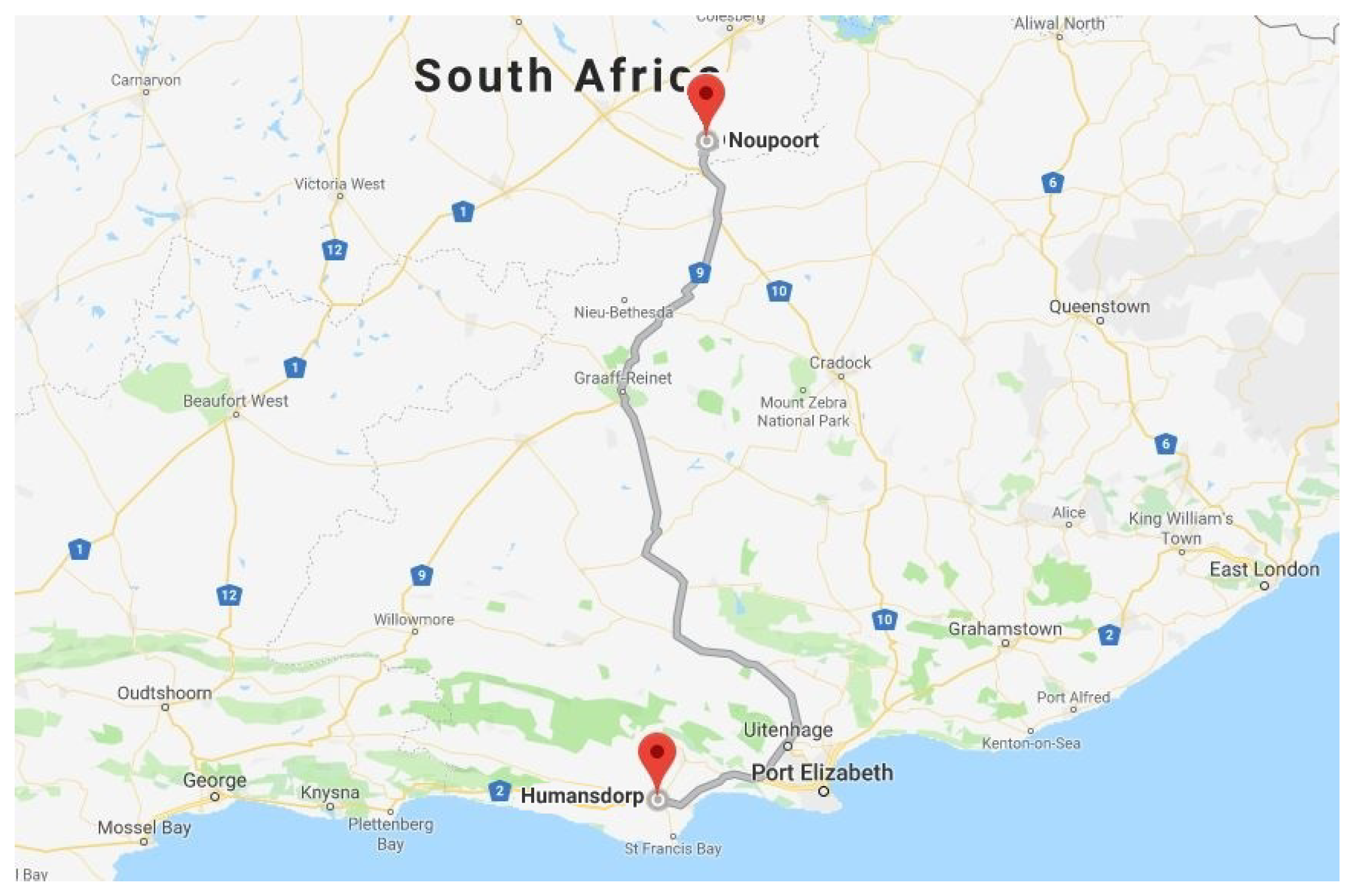
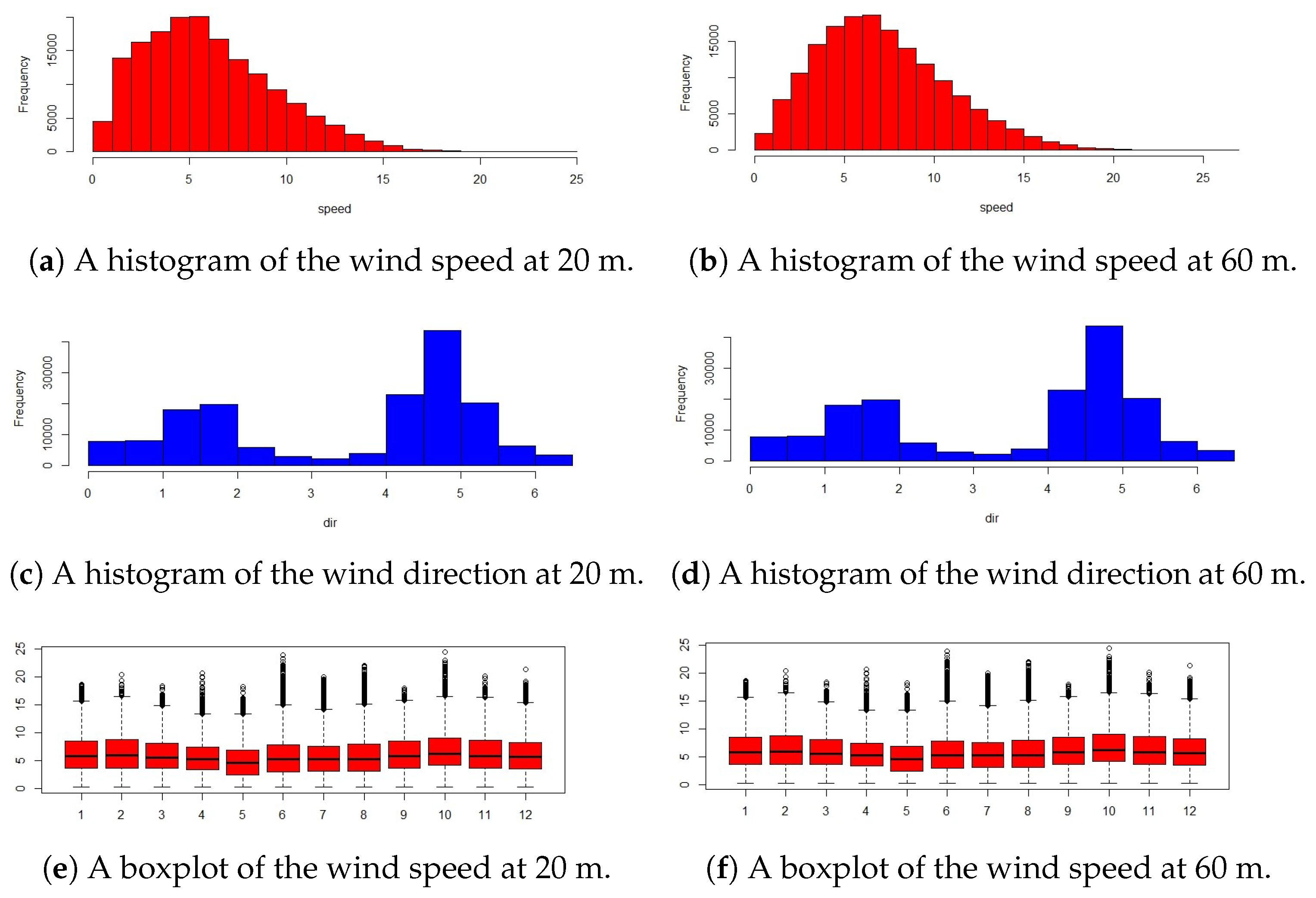
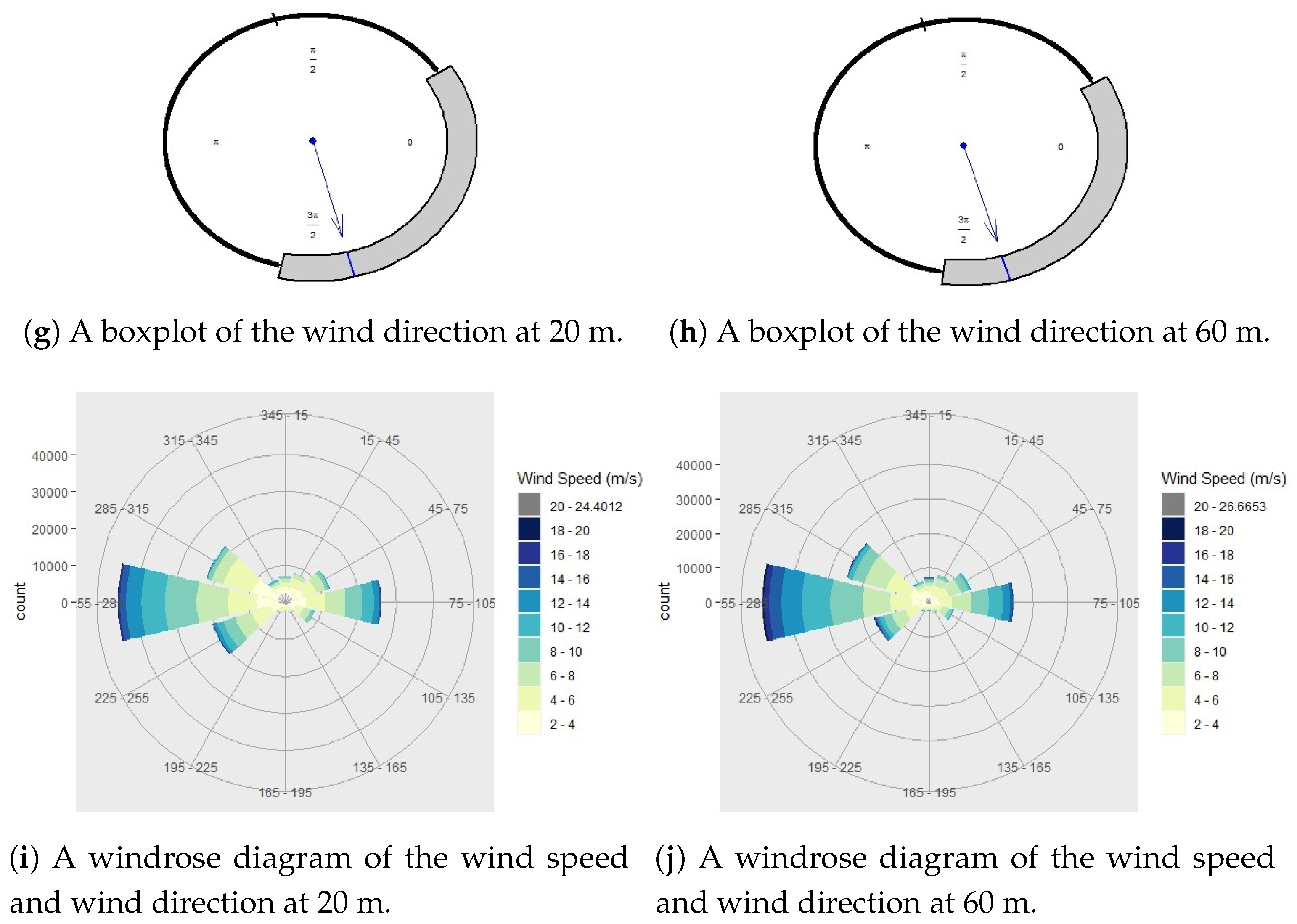
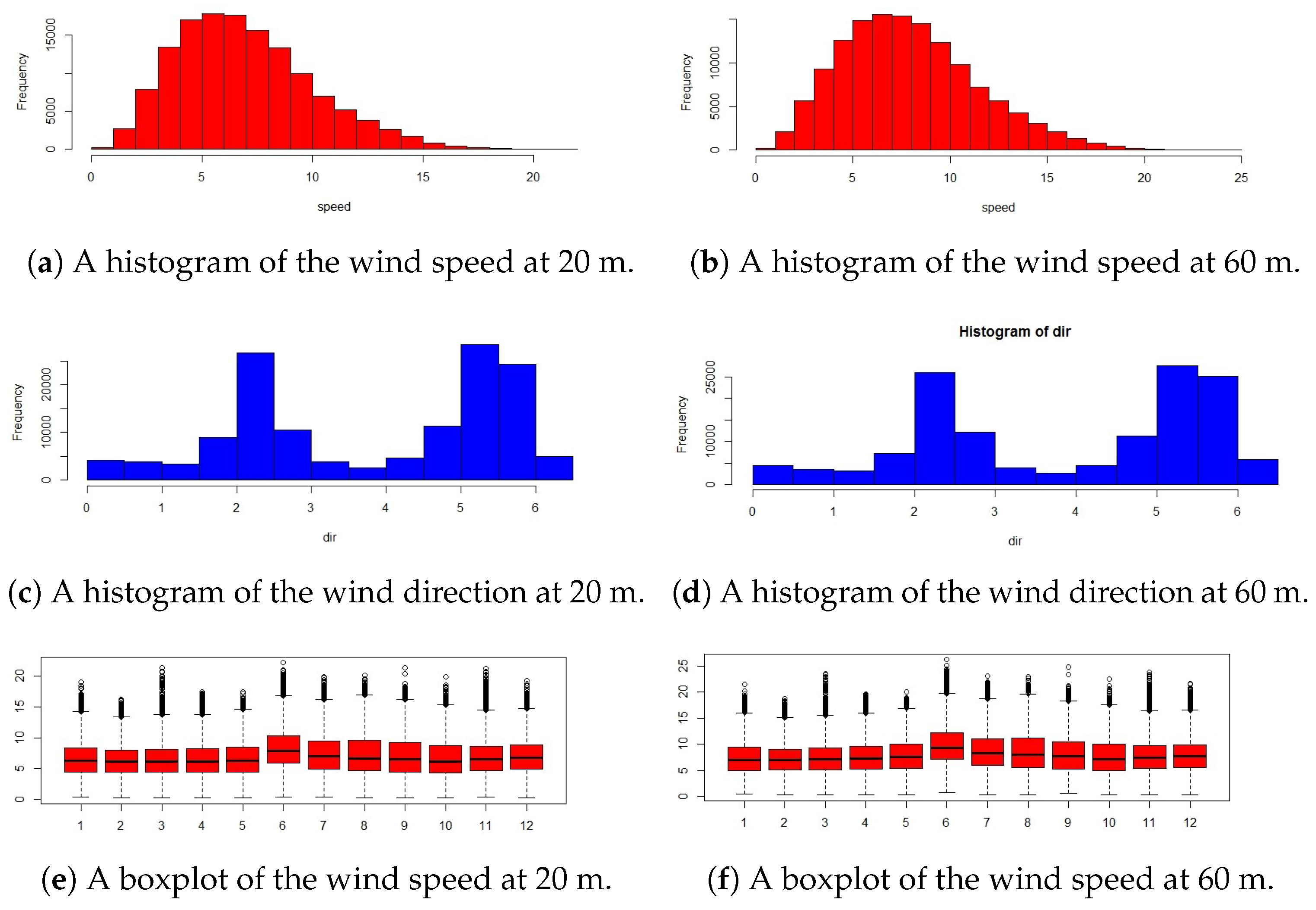
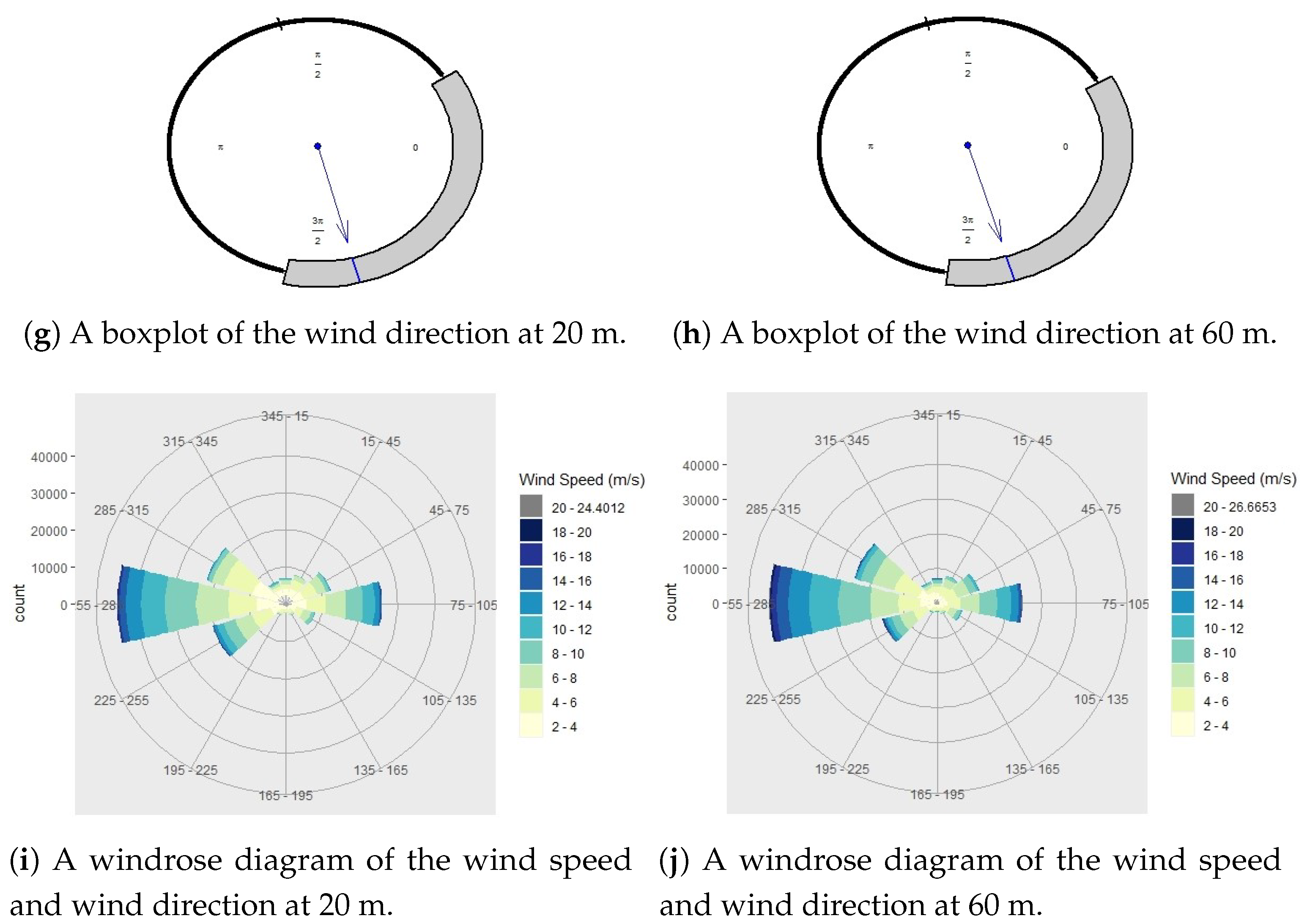
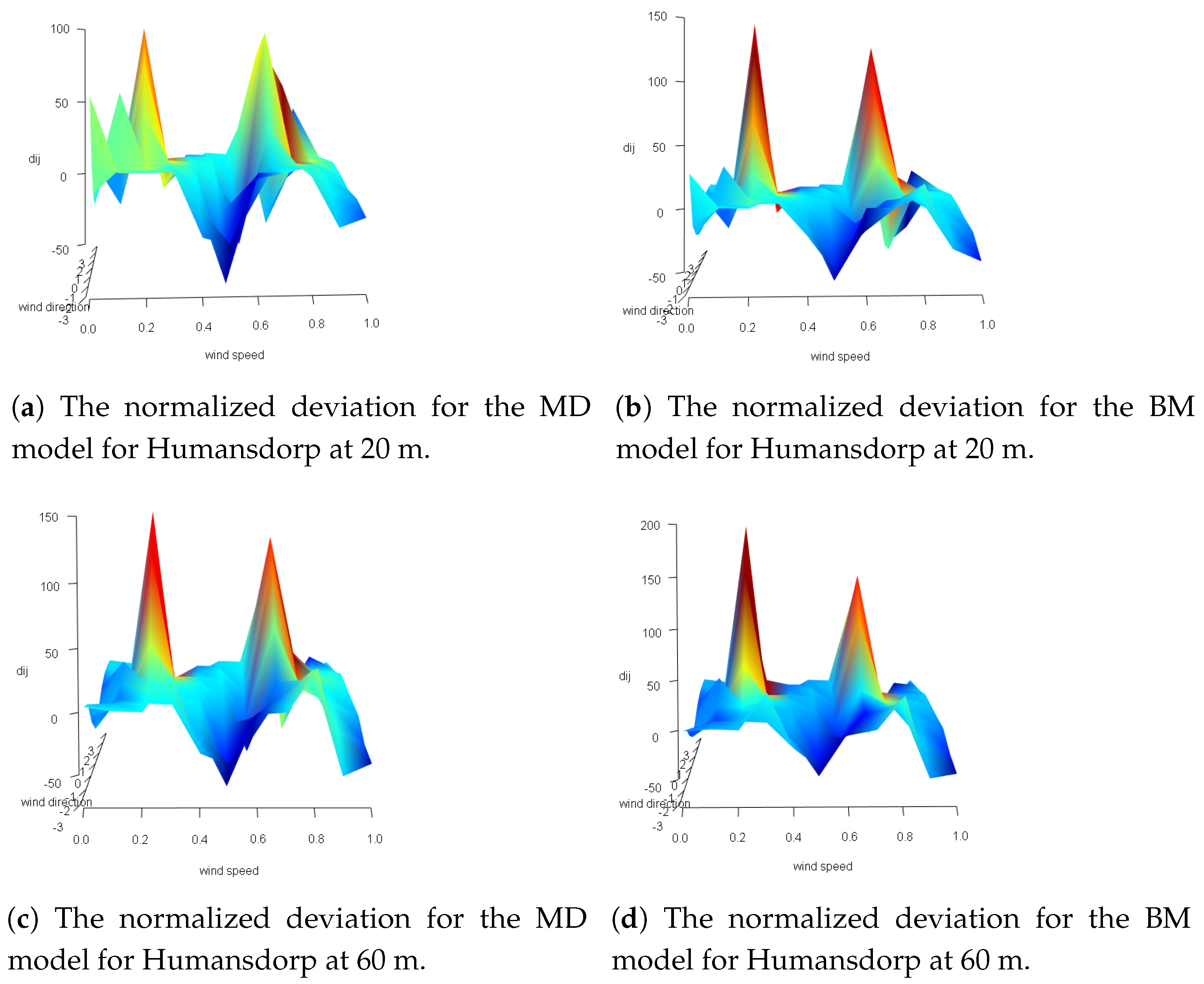
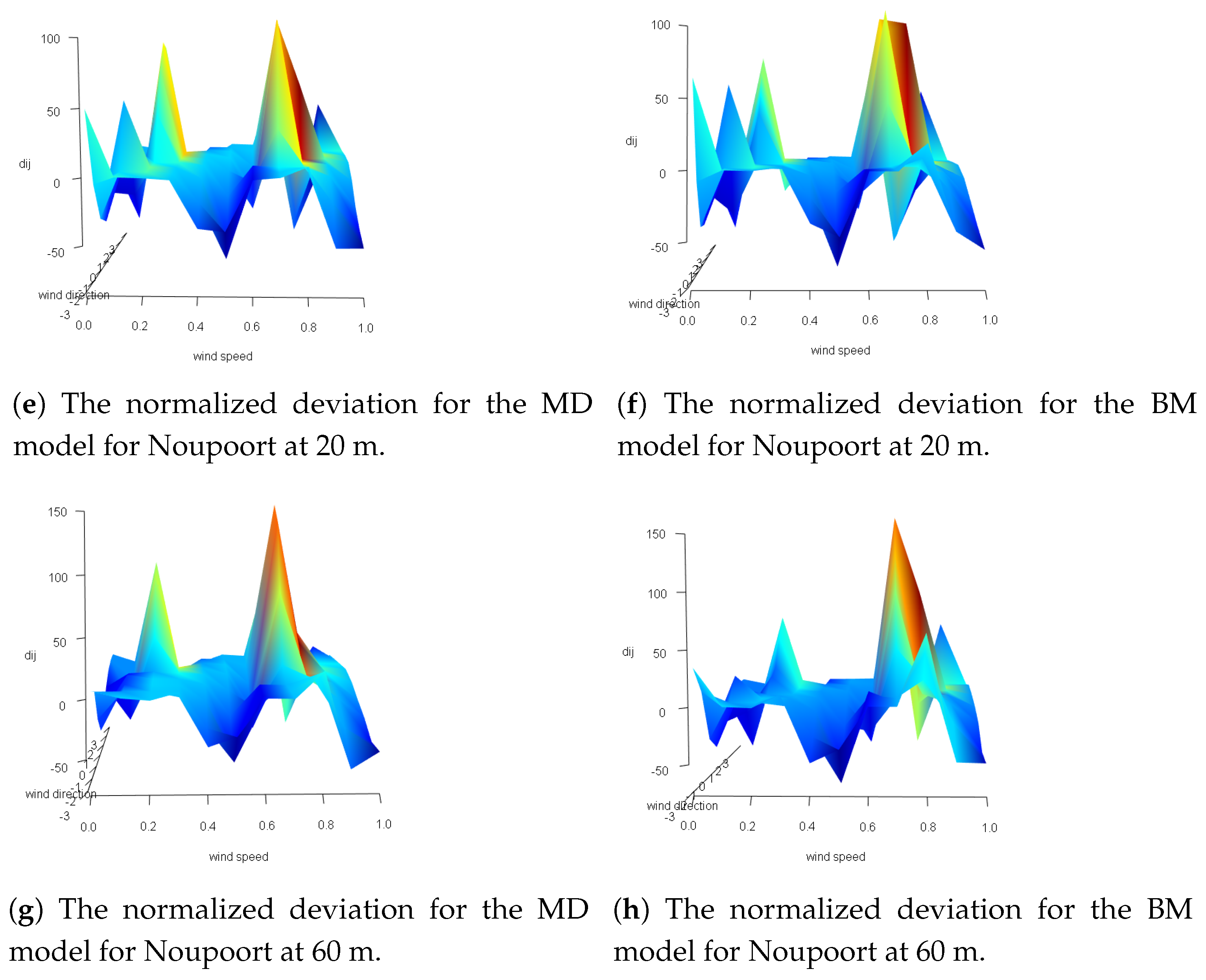
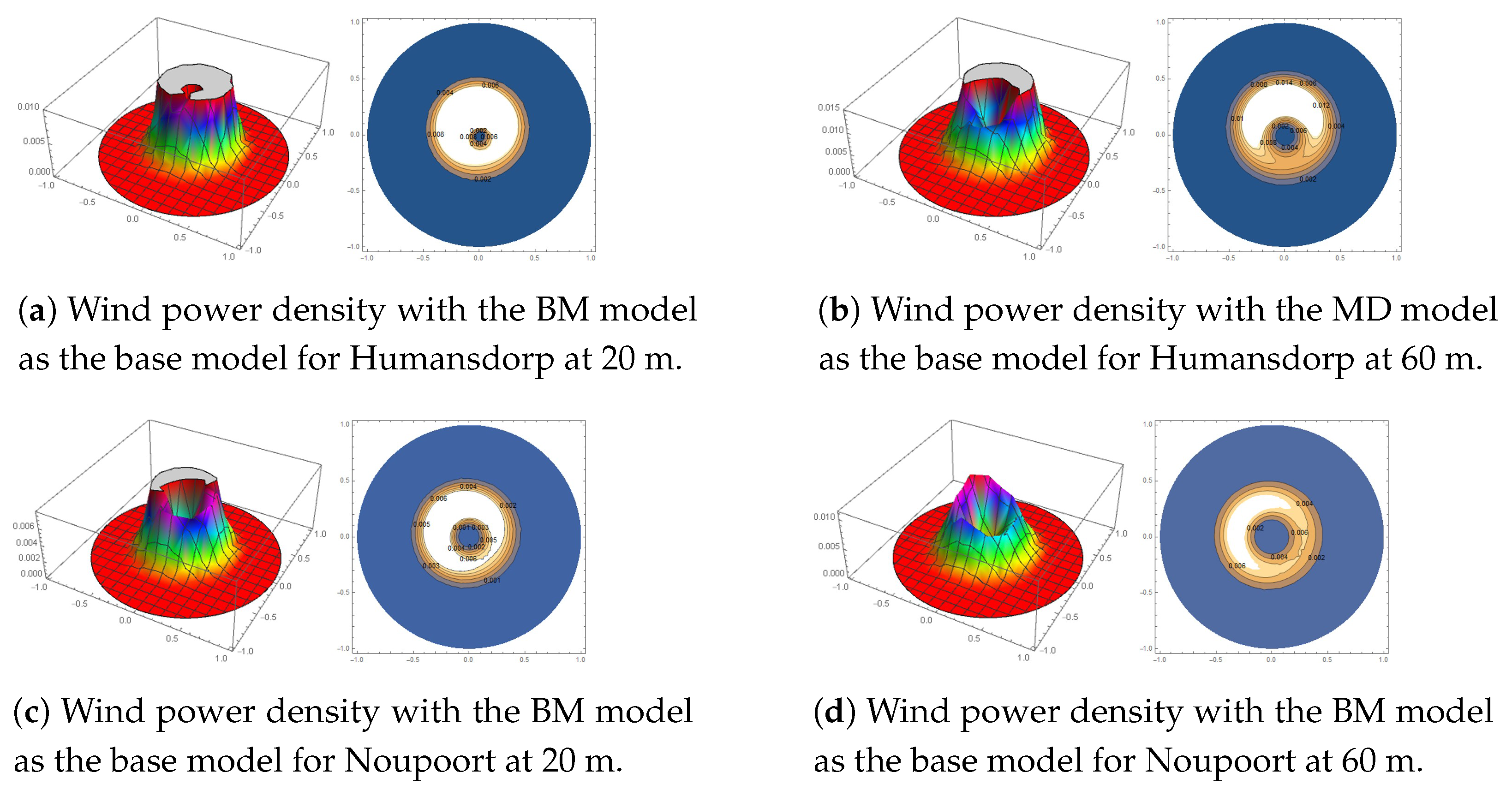
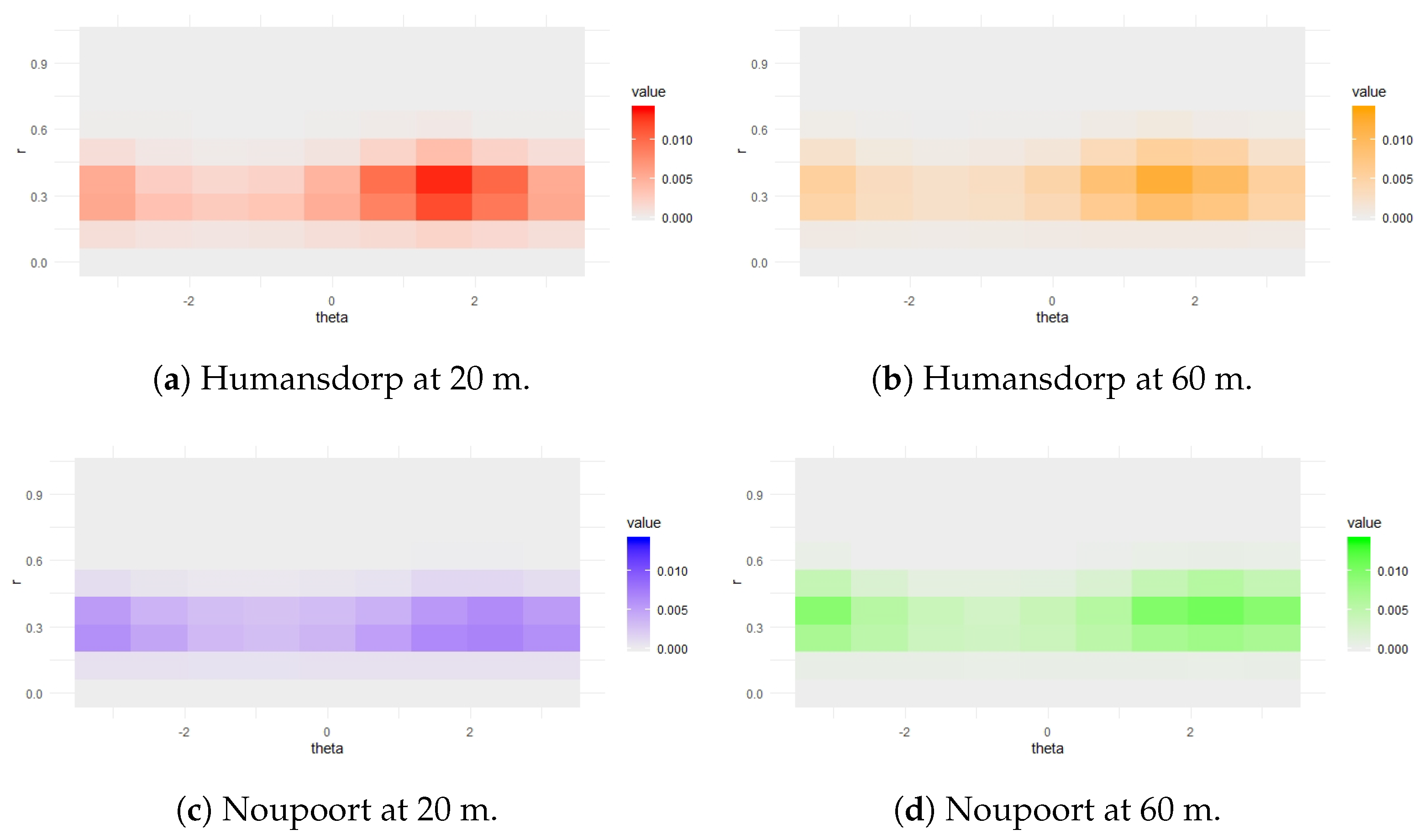
| Station | Latitude | Longitude | Elevation |
|---|---|---|---|
| (S) | (E) | (m) | |
| Humansdorp | −34.109965 | 24.514360 | 110 |
| Noupoort | 31.252540 | 25.028380 | 1806 |
| Station | Data Period (dd/mm/yyyy) | Total Data | Expected Data | Absent Data |
|---|---|---|---|---|
| Humansdorp | 01/01/2016–28/02/2019 | 166,226 | 166,320 | 94 |
| Noupoort | 01/01/2016–28/02/2019 | 137,660 | 166,320 | 28,660 |
| Station | Height (m) | Max (m/s) | Mean (m/s) | std (m/s) | Skewness | Kurtosis |
|---|---|---|---|---|---|---|
| Humansdorp | 20 | 24.40 | 6.01 | 3.40 | 0.68 | 0.16 |
| Humansdorp | 60 | 26.66 | 7.13 | 3.65 | 0.63 | 0.26 |
| Noupoort | 20 | 21.37 | 6.93 | 3.09 | 0.64 | 0.19 |
| Noupoort | 60 | 24.79 | 7.91 | 3.50 | 0.57 | 0.13 |
| Station | Height (m) | (rad) | s | k | ||||
|---|---|---|---|---|---|---|---|---|
| Humansdorp | 20 | 0.24 | −1.21 | 0.76 | 1.68 | 8.10 | 0.55 | −0.65 |
| Humansdorp | 60 | 0.28 | −1.16 | 0.72 | 1.60 | 6.22 | 0.60 | −0.71 |
| Noupoort | 20 | 0.14 | −0.82 | 0.86 | 1.99 | 23.92 | 0.04 | −0.72 |
| Noupoort | 60 | 0.15 | −0.88 | 0.85 | 1.95 | 20.69 | −0.08 | −0.74 |
| Model | Parameter Conditions | |
|---|---|---|
| MD | ||
| BM | , |
| Distribution | Probability Density Function | Domain of Definition | Parameter Conditions | |
|---|---|---|---|---|
| SPM | , | , | ||
| where | is a continuous function with support | |||
| MD | , | , , | ||
| BM | , | , , , |
| Metric | Equation |
|---|---|
| Station | Height (m) | Correlation Coefficient |
|---|---|---|
| Humansdorp | 20 | 0.2487562 |
| Humansdorp | 60 | 0.1711075 |
| Noupoort | 20 | 0.2688977 |
| Noupoort | 60 | 0.2677411 |
| Model | Estimates | Estimates | ||||||
|---|---|---|---|---|---|---|---|---|
| AIC | BIC | HQC | ||||||
| Humansdorp at 20 m | ||||||||
| SPM | 0.06 | 1.643 | - | - | −50,073.496 | 100,150.992 | 100,171.034 | 100,161.912 |
| MD | 0.06 | 1.61 | 19.99 | - | −137,147.608 | 274,301.217 | 274,331.280 | 274,310.136 |
| BM | 0.05 | 1.84 | 12.58 | 0.82 | −128,863.955 | 257,735.910 | 257,775.994 | 257,747.8033 |
| Humansdorp at 60 m | ||||||||
| SPM | 0.06 | 1.71 | - | - | −134,644.097 | 269,292.195 | 269,312.237 | 269,303.114 |
| MD | 0.06 | 1.75 | 19.06 | - | −143,268.526 | 286,543.052 | 286,573.115 | 286,551.972 |
| BM | 0.07 | 1.94 | 10.43 | 0.89 | −143,270.191 | 286,548.383 | 286,588.467 | 286,560.2753 |
| Noupoort at 20 m | ||||||||
| SPM | 0.03 | 2.26 | - | - | −98,121.666 | 196,247.332 | 196,266.997 | 196,258.1571 |
| MD | 0.05 | 2.20 | 19.92 | - | −105,008.477 | 210,022.953 | 210,052.451 | 210,031.7791 |
| BM | 0.04 | 2.28 | 13.69 | 1.23 | −102,044.187 | 204,096.373 | 204,135.704 | 204,108.1408 |
| Noupoort at 60 m | ||||||||
| SPM | 0.05 | 2.33 | - | - | −119,253.019 | 238,510.038 | 238,529.703 | 238,520.8631 |
| MD | 0.05 | 2.33 | 15.89 | - | −121,825.312 | 243,656.624 | 243,686.122 | 243,665.4491 |
| BM | 0.03 | 2.67 | 12.24 | 1.4 | −120,573.788 | 241,155.575 | 241,194.905 | 241,167.3428 |
| Station | Height (m) | Model | Median | Range |
|---|---|---|---|---|
| Humansdorp | 20 | MD | −0.2708471 | (−86.41038; 114.30956) |
| Humansdorp | 20 | BM | −0.2757685 | (−66.82174; 168.59107) |
| Humansdorp | 60 | MD | −0.3938287 | (−73.57794; 154.53348) |
| Humansdorp | 60 | BM | −0.8428266 | (−74.65866; 201.50158) |
| Noupoort | 20 | MD | −0.4002134 | (−84.15884; 116.17518) |
| Noupoort | 20 | BM | −0.2386832 | (−80.73554; 126.18355) |
| Noupoort | 60 | MD | −0.3757053 | (−76.41617; 162.44165) |
| Noupoort | 60 | BM | −0.08373657 | (−73.58869; 179.88564) |
© 2020 by the authors. Licensee MDPI, Basel, Switzerland. This article is an open access article distributed under the terms and conditions of the Creative Commons Attribution (CC BY) license (http://creativecommons.org/licenses/by/4.0/).
Share and Cite
Arashi, M.; Nagar, P.; Bekker, A. Joint Probabilistic Modeling of Wind Speed and Wind Direction for Wind Energy Analysis: A Case Study in Humansdorp and Noupoort. Sustainability 2020, 12, 4371. https://doi.org/10.3390/su12114371
Arashi M, Nagar P, Bekker A. Joint Probabilistic Modeling of Wind Speed and Wind Direction for Wind Energy Analysis: A Case Study in Humansdorp and Noupoort. Sustainability. 2020; 12(11):4371. https://doi.org/10.3390/su12114371
Chicago/Turabian StyleArashi, Mohammad, Priyanka Nagar, and Andriette Bekker. 2020. "Joint Probabilistic Modeling of Wind Speed and Wind Direction for Wind Energy Analysis: A Case Study in Humansdorp and Noupoort" Sustainability 12, no. 11: 4371. https://doi.org/10.3390/su12114371
APA StyleArashi, M., Nagar, P., & Bekker, A. (2020). Joint Probabilistic Modeling of Wind Speed and Wind Direction for Wind Energy Analysis: A Case Study in Humansdorp and Noupoort. Sustainability, 12(11), 4371. https://doi.org/10.3390/su12114371






